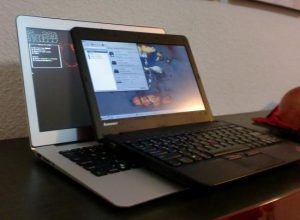KDE Slimbook and FreeBSD
Yesterday I picked up my new KDE Slimbook. It comes with KDE Neon pre-installed. Of course it also works well with openSUSE, and Manjaro, and Netrunner Linux (some things I've at least booted the Live CD for). But for me, "will it run FreeBSD" is actually the most important bit.
Yes. Yes it does, and it does so beautifully.
That is at least one advantage of choosing a Free Software friendly laptop, one designed for GNU/Linux: it is likely to be supported by many more operating systems that you might like. No, I have not tried OpenSolaris / Illumos on it .. there's really no desktop distro in that corner anymore.
So, here's how to breakupgrade your Slimbook to FreeBSD (no warranty implied):
- Resize the installed partition to make space for FreeBSD. I chopped 40GB off the end of the main Linux partition. This may break various crypt-setup things, be careful. For resizing, I actually used the Manjaro installer, and told it to resize an existing partition, then cancelled the install during unsquash, and then deleted the partition it had made. You can probably use resize2fs and gparted with good effect, too.
- Install FreeBSD 12-CURRENT. I went for UFS on a single partition, no swap: that's the easiest to get right, and avoids weirdness like zpools on a partition. It ended up in ada0p4, or sda4, or (hd0, gpt4) depending on what nomenclature you use for naming disks.
- Oh, yeah .. don't install a boot manager for FreeBSD. We'll let the existing GRUB deal with it.
- Reboot and let GRUB start Linux again. We'll configure GRUB to (also) start FreeBSD. Add an OS entry for FreeBSD, by adding
/etc/grub.d/40_custom:
menuentry "FreeBSD" --class freebsd --class bsd --class os {
insmod ufs2
insmod bsd
set root=(hd0,gpt4)
chainloader /boot/boot1.efi
}
Also recommended: set timeouts so you can actually pick an OS, in
/etc/grub.d/custom.cfg:
set timeout=5
set timeout_style=menu
- Reboot, hit escape at the right moment to get the GRUB menu, and choose FreeBSD. Boot into FreeBSD.
- Configure wireless networking on FreeBSD for the Slimbook. I have one with an Intel 7265 wireless card, so I needed to set that up. Since the firmware comes from the filesystem, I ended up following the quick-start guide and futzing with
rc.localto load the driver. Here's myrc.local:
#! /bin/sh
/sbin/kldload if_iwm
/sbin/ifconfig wlan0 create wlandev iwm0
:
and this is a bit of my
rc.conf:
# Wireless
wlans_iwm0="wlan0"
ifconfig_wlan0="WPA SYNCDHCP"
Bear in mind that NetworkManager and other fancy bits are not available: configure
wpa_supplicant.confby hand and add SSIDs and PSKs there. - Right now, Intel IGP after Broadwell (and the Slimbook is a Skylake) isn't fully supported by the xf86-video-intel driver, so instead use scfb. This loses acceleration and some other features, but it gives you X11 right now, as opposed to sometime later when the newer drivers are merged.
pkg install xf86-video-scfbAdd some explicit, manual, X.org configuration:
Section "Device"
Identifier "Card0"
Driver "scfb"
EndSection
- After that, follow my earlier Plasma 5 on FreeBSD HOWTO, including adding the Area51 repo. However, since this is 12-CURRENT, you need to use a different pkg repository URL.
This concludes my laptop-futzing-about at Akademy this year: I have a laptop that dual-boots Linux and FreeBSD, and gives me an up-to-date Plasma 5 Desktop and KDE Applications on both -- but that leaves me free to hack on whatever my work requires in the OS best suited to it each day of the week.
